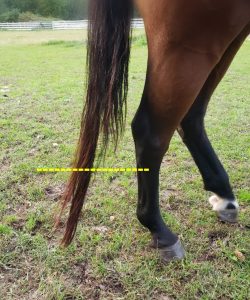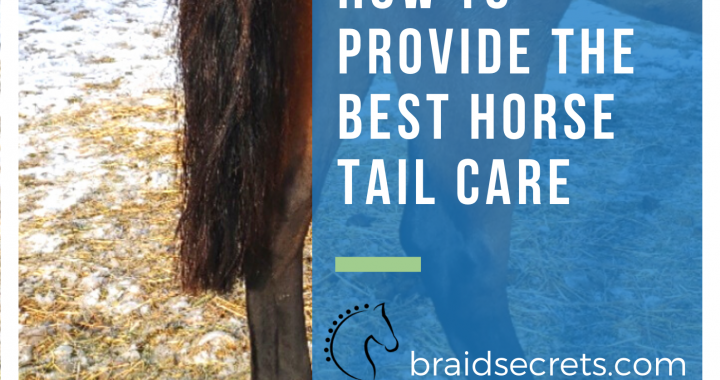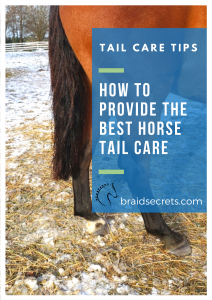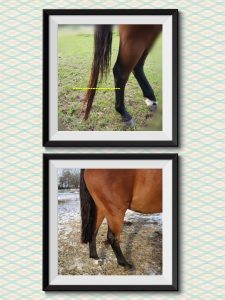HOW TO PROVIDE THE BEST HORSE TAIL CARE
It’s that time of year again when I do this somewhat shocking thing to provide the best horse tail care for my horse.
I cut my horse’s tail off below the hocks.
Yep, you read that right.
Most riders have ideas about how to provide the best horse tail care. Here’s the back story about why I started cutting my horse’s tail short in the fall as part of my horse tail care strategy. Plus, you’ll learn what I do instead of daily tail combing and what the results have been.
HOW I LEARNED THE BEST HORSE TAIL CARE TIP
It all started when I traveled a couple of hours to my instructor’s barn for a coveted lesson with him on one of his horses.
As I walked through the barn, I noticed that every single horse had an amazing, full tail. The kind of lush, bushy tails that swing rhythmically to a horse’s every movement like exclamation points to their performance. Those kinds of tails!
Since the horses in the barn weren’t all the same breed I wondered, how is that even possible?
That lead me to ask him, what are you doing to their tails to get them so full and beautiful?”
He just smiled and said that he cut their tails short every fall after fly season had ended. He also told me that he didn’t brush their tails out every day.
Instead he conditioned them and only combed them out by hand for shows and clinics.
After seeing those tremendous tails, I decided to adopt his tail care strategy and use it on my own horses.
GET A THICKER, HEALTHIER TAIL
Have you ever seen a person with long, wispy hair after they get a bob haircut? Instantly, their hair appears so.much.thicker. It’s the same concept here just with horse tails.
Each fall I cut my horse’s tail off a few inches below his hocks to the collective gasp of my fellow riders.
But this strategy works wonders for creating an amazing tail.
 My horse Gold Dust (aka Dusty) is a good case in point. I’ve been cutting his tail for a couple of years now.
My horse Gold Dust (aka Dusty) is a good case in point. I’ve been cutting his tail for a couple of years now.
Originally, his tail was mostly short with one long, very thin piece reaching his pastern. Each fall I cut several inches off Dusty’s tail once fly season ended here in the Midwest, usually in late October.
The yellow line in this photo shows the length I will cut his tail to this year.
Note: The longer portion of his tail pictured here used to be one-third as thick as it is now.
By cutting several inches off his tail each fall, the short pieces can catch up in length with the rest of the tail.
TAIL COMPARISON PHOTOGRAPHS
In these before and after comparison photographs, you can see how the short pieces on the right side of the tail have almost grown down to the cut point.
Note how much thicker the tail appears after a trim.
These pictures were taken just days apart after the first winter storm of the season blew through our area.
HOW TO CUT A HORSE’S TAIL
If your horse’s tail gets thinner toward the bottom or you just want the tail to be thicker, cut the tail with a pair of scissors to a few inches below the hocks after the flies are gone in your area and your show season has ended.
Before you get started, snag a precision pair of hair cutting scissors for your grooming kit.
Why not just use any pair of scissors?
Regular scissors aren’t nearly as sharp as hair cutting scissors, so they bend the hair before cutting. This makes it difficult to get the clean, precision cut you’re looking for.
I recommend using hair cutting or barber shears because they’re extremely sharp and made for precision hair cutting. The pair I linked to above are stainless steel, light weight, and have an ergonomic shape. They also feature an easy grip, no slip design which helps deliver a super soft and confident cut every time. They come with a storage case and they’ll last you forever.
Now that you have a quality pair of scissors, let’s walk through the steps of how to cut a tail:
- First, make sure your horse’s tail is combed out and free from any tangles.
- Next, put a crop, polo wrap or your friend’s arm under the tail (you know your horse the best), so the tail hangs slightly away from your horse’s body. This simulates the position of the tail when your horse is under saddle.
- Comb the tail hair straight down and run your fingers down the tail hair so that the hair is smooth, organized and clamped between your first and second fingers, like a hairdresser’s hand just before they cut. Ideally, your hand will be parallel to the ground and you’ll be standing off to one side of your horse’s haunches.
- Then carefully cut the tail straight across (for dressage horses), parallel to the floor just below your fingers.
That’s it! You’ll notice that the tail will appear much fuller after cutting.
What if you’re not a dressage rider?
See my tip below for creating a less blunt tail for other disciplines like hunters.
Pro Tip: To create a less blunt tail bottom use this cosmetology technique referred to as chipping to soften blunt ends:
- Hold the scissors in a vertical position so the tips are pointed at the hair ends but slightly angled.
- Snip small bits of hair out (1⁄4-inch deep) across the blunt cut (skipping some hair between snips) so that the ends become slightly uneven. I typically hold the tail off to one side of the horse during this process. Be extra careful not to snip your fingers since you will be cutting toward them. Keep your hand and fingers at least two inches from the bottom of the tail when chipping.
- Alternate Method: Chip across the tail to shorten it without making a blunt cut first.
I usually cut about six inches off my horse’s tail, so it falls somewhere between the bottom of the hock joint and pastern.
A word of caution: I don’t go shorter than five inches below the hock because you want the tail to grow to near or at the pastern by late spring when the flies return.
HORSE TAIL CARE TIP – APPLY THE BEST CONDITIONER
After cutting my horse’s tail, I apply my favorite conditioner to it. To apply the conditioner, I put a small amount of conditioner in my hands and work it through the tail. I love this conditioner because it’s so darn effective, prevents tangling, doesn’t attract dirt and gives the tail a beautiful shine. Get yours here.
Then I leave the tail alone, only hand-pick shavings out daily. Occasionally, apply more conditioner to prevent tangling, if needed.
Remember you want to preserve the hair you have, so condition the tail and treat it with the utmost care. Racking through the tail daily with a comb can cause hair breakage. Handing pick the tail instead makes a significant difference over time in tail thickness.
HOW TO HAND PICK THE TAIL
I hand pick (detangle) my horse’s tail for clinics or horse shows only. To do this grasp the entire tail in one hand. Then begin separating small strands of tail hair out, untangling by hand.
I’m not going to lie; it takes a little patience. BUT you won’t be disappointed with the results because hand sorting the tail gives your horse’s tail a super full appearance that you’re going to love.
HORSE TAIL CARE RESULTS
By spring, Dusty’s tail grows down to at or near his pastern and is much fuller.
By using this horse tail care strategy, Dusty’s tail gets fuller and healthier each year. Plus, a full tail is more effective for swatting flies.
CUMULATIVE EFFECT OF TAIL TRIMMING
It’s been my experience that cutting the tail every year has a cumulative effect and your horse will have a much thicker tail in the end!
Here’s one additional tip. I don’t recommend using a tail bag. I have personally seen a couple of horses lose one third to one half of their tails when a section of the braided tail just above the bag got caught on something.
LIMIT HORSE TAIL HAIR BREAKAGE
I have owned a couple of horses whose tails broke off easily during fly season due to constant fly swatting. If your horse’s tail breaks off easily, consider using a fly sheet to best preserve the hair. Less tail swishing equals less hair breakage. Just make sure they don’t get too hot under the fly sheet.
HORSE TAIL CARE RECAP
I hope you adopt this horse tail care strategy and create the best tail ever on your horse. Here’s a quick recap of the strategy:
- After the flies are gone in your area and your show season has ended, trim your horse’s tail to a few inches below the hock.
- Work a quality conditioner throughout the tail by hand
- For daily care, avoid combing the tail out. Instead hand pick shaving out if needed.
- Hand pick (detangle) the tail for shows or clinics only.
That sums it up on how to provide the best horse tail care. Steal my horse tail care strategy and one day soon you’ll have a visitor at your barn who will be walking around wondering how come all your horses have such amazing tails.
Do you have a great tail tip? Dont’ keep it to yourself! Please share it in the comments below.
Cheers!
Mary Beth
Shop this post:
Recent Posts >>> Find the Best Gifts for Horse Lover’s Right Here



Great tips, thank you!
Thanks Joy! I plan to share of picture of Dusty’s tail in the spring so you can see the end results.
I thoroughly enjoyed your post on horse tail care – it’s evident you’re deeply passionate about the well-being of our equine friends. While you didn’t specifically touch on the term hot horse your comprehensive tips for maintaining a healthy and glossy tail reflect a broader dedication to overall horse health and comfort. Keeping a horse’s tail in top-notch condition contributes to their happiness and confidence, which is crucial for any equestrian. Your insights are valuable, and I appreciate the care and attention you emphasize in ensuring our horses are at their best.
Really good info can be found on site.